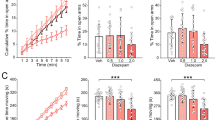Summary
Ketotifen was compared to diazepam to inhibit aversive responding of the mouse in a black and white test box and in the rat social interaction test. Both drugs reduced aversive responding in the mouse to the brightly illuminated area of the test box and facilitated social interaction in the rat; ketotifen was approximately 100 times more potent than diazepam. The chronic administration of diazepam, ethanol, nicotine and cocaine in the mouse also reduced aversive responding but their withdrawal was associated with an increased behavioural suppression. The administration of ketotifen during the period of withdrawal from diazepam, ethanol, nicotine and cocaine prevented the exacerbation in aversive responding. It is concluded that ketotifen, like diazepam and 5-HT3 receptor antagonists, can reduce behavioural suppression in rodent models of anxiety and attenuate the behavioural consequences of withdrawal from treatment with drugs of abuse.
Similar content being viewed by others
References
Bardo MT, Neisewander JL, Ennis RB (1988) Chronic treatment with naltrexone enhances morphine-stimulated dopamine neurotransmission: neurochemical and behavioural evidence. Neuropharmacology 27:1103–1109
Barnes JC, Barnes NJG, Barnes NM, Costall B, Domeney AM, Naylor RJ (1987) Ketotifen can antagonise changes in sensitivity of cerebral dopamine receptors: behavioural correlates in rodent and primate. Neuropharmacology 26:693–700
Barry JM, Costall B, Kelly ME, Naylor RJ (1987) Withdrawal syndrome following subchronic treatment with anxiolytic agents. Pharmacol Biochem Behav 27:239–245
Bell J, Bickford-Wimer PC, de la Garza R, Egan M, Freedman R (1988) Increased central noradrenergic activity during benzodiazepine withdrawal: an electrophysiological study. Neuropharmacology 27:1187–1190
Bretz U, Mazzoni ML, Ney UM (1983) β-adrenergic tachyphylaxis in the rat and its reversal and prevention by ketotifen. Eur J Pharmacol 86:321–328
Bretz U, Martin U, Ney UM (1984) Drug effects on β-adrenoceptor function in experimental animals. In: Beta-adrenoceptors in asthma. Academic, London, pp 227–238
Brodde O-E, Brinkmann M, Schemuth R, O'Hara N, Dual A (1985) Terbutaline-induced desensitisation of human lymphocyte β2-adrenoceptors. J Clin Invest 76:1096–1101
Charney DS, Sternberg DE, Kleber HD, Heniger GR, Redmond E (1981) The clinical use of clonidine in abrupt withdrawal from methadone: effects on blood pressure and specific signs and symptoms. Arch Gen Psychiatry 38:1273–1278
Costall B, Kelly ME, Naylor RJ (1988) The anxiolytic and anxiogenic actions of ethanol in a mouse model. J Pharm Pharmacol 40:197–202
Costall B, Jones BJ, Kelly ME, Naylor RJ, Onaivi ES, Tyers MB (1990) The potential of ondansetron to inhibit the behavioural consequences of withdrawing from chronic treatment with drugs of abuse. Pharmacol Biochem Behav (in press)
Costall B, Jones BJ, Kelly ME, Naylor RJ, Tomkins DM (1989a) Exploration of mice in black and white test box: validation as a model of anxiety. Pharmacol Biochem Behav 32:777–785
Costall B, Kelly ME, Naylor RJ, Onaivi ES (1989b) The actions of nicotine and cocaine in a mouse model of anxiety. Pharmacol Biochem Behav 33:197–203
Crawley JN (1981) Neuropharmacological specificity of a simple animal model for the behavioural actions of benzodiazepines. Pharmacol Biochem Behav 15:695–699
Dwaskin LP, Peris J, Yasuda RP, Philpott K, Zahniser NR (1988) Repeated cocaine administration results in supersensitivity of striatal D-2 dopamine autoreceptors to pergolide. Life Sci 42:255–262
File SE (1981) The use of social interaction as a method for detecting anxiolytic activity of chlordiazepoxide-like drugs. J Neurosci Methods 2:219–238
Hajós M, Engberg G (1988) Role of primary sensory neurons in the central effects of nicotine. Psychopharmacology 94:468–470
Martin U, Romer D (1978) The pharmacological properties of a new orally active antianaphylactic compound: ketotifen, a benzocycloheptathiophene. Arzneimittelforschung 28:770–782
Pitts DK, Marwah J (1986) Electrophysiological effects of cocaine on central monoaminergic neurons. Eur J Pharmacol 131: 95–98
Snape BM, Engel JA (1988) Ethanol enhances the calcium dependent stimulus-induced release of endogenous dopamine from slices of rat striatum and nucleus accumbens in vitro. Neuropharmacology 27:1097–1101
Wilkins AJ, Jenkins DE, Steiner JA (1983) Efficacy of clonidine in treatment of alcohol withdrawal state. Psychopharmacology 81:78–80
Author information
Authors and Affiliations
Additional information
Send offprint requests to B. Costall at the above address
Rights and permissions
About this article
Cite this article
Costall, B., Kelly, M.E., Onaivi, E.S. et al. The effect of ketotifen in rodent models of anxiety and on the behavioural consequences of withdrawing from treatment with drugs of abuse. Naunyn-Schmiedeberg's Arch Pharmacol 341, 547–551 (1990). https://doi.org/10.1007/BF00171735
Received:
Accepted:
Issue Date:
DOI: https://doi.org/10.1007/BF00171735



